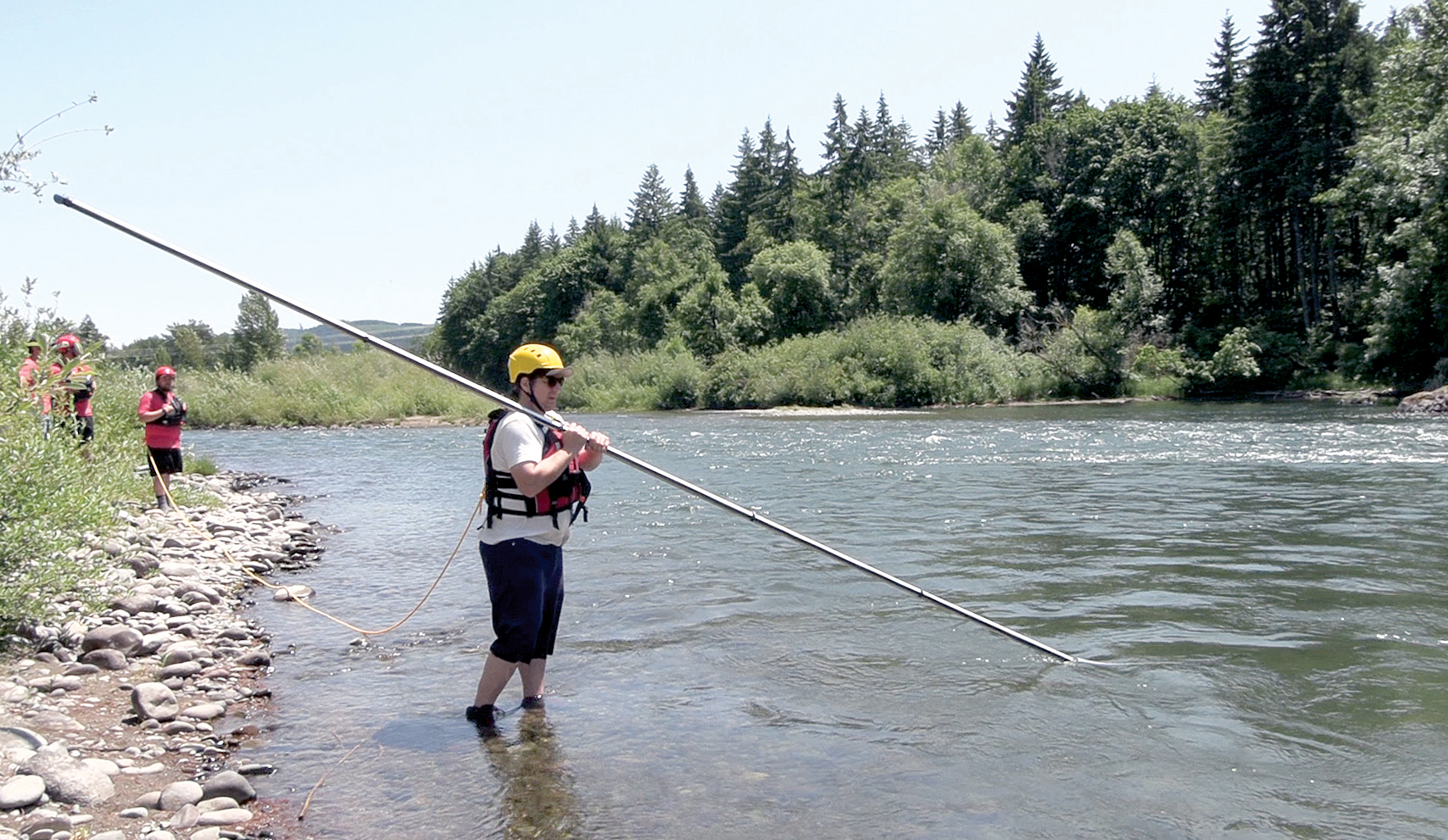Culture
Tribe celebrates perseverance, restoration

By Nicole Montesano
Smoke Signals staff writer
Although no salmon landed in the Tribe’s fishing nets during its Celebration of Perseverance at its Chankawan Conservation Area Thursday, June 5, participants said they welcomed the chance to spend a perfect late spring day enjoying the sunshine on the bank of the North Santiam River in Stayton.
Silvery-leaved willow shrubs lined both banks of the rocky shoreline. Bald eagles and red-tailed hawks occasionally soared overhead, as a crowd of Tribal members and employees gathered to hear about how the Tribe has been working to restore the 425-acre property over the past nine years.
Ceremonial fishers, wearing helmets and safety gear, were undeterred by the fast current and cold water, although several chose to dip their nets from the top of a massive ice-age boulder rather than standing in mid-stream.
“I needed this,” Tribal Council member Kathleen George said, lifting her face to the warm sun.
In addition to Kathleen George, Tribal Council Secretary Jon A. George and council members Denise Harvey and Brenda Tuomi attended the celebration. Jon A. George delivered the invocation and drummed with Tribal singers performing a song.
Part of the fun, Kathleen George said, was trying to figure out which nets and techniques are better suited to the Santiam’s open, less turbulent waters, which differ greatly from the pounding deluge at Willamette Falls, where the Tribe fishes from a platform set over the falls.
On the shore, set back from the rocky beach, members of the Cultural Resources Department tended a small fire in the event it was needed for a First Fish ceremony, adding the fragrance of woodsmoke to the scents of river and forest. The Tribe set out chairs and tables of food, although as the day warmed, many people retreated to the shade. Others stood on the edge of the water, watching the fishing.
The celebration served multiple purposes. It provided another chance to catch the first salmon of the year, after disappointing water conditions at Willamette Falls this year, and honored the Tribe’s perseverance in practicing its traditional fishing rights. It also gave the Natural Resources Department a chance to share its work on the property with the Tribe.
Tribal Fish & Wildlife Program Manager Kelly Dirksen told the crowd he first thought about holding a celebration at Chankawan in April, while attending the trial over Portland General Electric’s effort to condemn and seize ownership of Willamette Falls. The four-day trial took place at the Mark O. Hatfield U.S. Courthouse in Portland. A judgement has not yet been issued in the case.
“I thought of coming out here at some point on the 15th floor of the courthouse, when I was thinking of anyplace else I’d rather be,” Dirksen said. “So, I wanted to come out here and I wanted to drag all of you with me.”
The day was a chance, Dirksen said, to “recharge our batteries,” to relax and celebrate after the grueling trial and uncertainty regarding the future of the Tribe’s fishing platform.
“I believe we will fish at Willamette Falls again,” Dirksen said. “But in the meantime, we’ll fish here.”
The advantage of Chankawan, he said, is that, “We can bring everybody here.”
Dirksen spoke briefly about the trial, praising Assistant Tribal Attorney Kim D’Aquila’s knowledgeable defense of the case.
Kathleen George did not directly address the trial but said it has been “a really hard season, … a hard few seasons,” as the Tribe has fought for its land, its fishing rights, its fishing platform and the future of salmon.
“We came from people who have come from the hardest of seasons … and their strength, their preservation and their courage have paid off,” George said.
The North Santiam River’s floodplain and surrounding area was originally home to the Santiam Band of the Calapooia, Tribal Restoration Ecologist/Fish & Wildlife Policy Analyst Lindsay McClary told the audience.
“It was an important place for salmon,” McClary said.
The construction of Detroit Dam has changed how the river flows, decreasing water volume and eliminating the seasonal flooding that once created habitat.
“This land was used and abused,” she said.
The Tribe named the property Chankawan, the Calapooian word for salmon, she said, and set about restoring it, including removing massive amounts of invasive Scotch broom and Himalayan blackberry that blocked access to the river. They also removed trash and dilapidated housing, she said. The Tribe acquired more than $1 million in state and federal grants, as well as private non-profit funds, for its work on the property.
“I feel like a lot of my role is undoing what people did 50 or 100 years ago,” McClary said.
The restoration work is not finished, she said, noting that after decades of abuse, it will take decades to restore. Eventually, the Tribe hopes to allow camping and hunting on the property, but for now, those activities are prohibited. Day use permits, however, are allowed.
Eventually, McClary hopes to see the floodplain forest restored, filled with Oregon ash, big leaf maple, black cottonwood, red alder, hazel, snowberry and thimbleberry, as well as camas in the wetter areas.
“We’re never going to restore it to its pre-European settlement state, but we will restore it to the extent possible in today’s political, social and economic climate,” she said.
